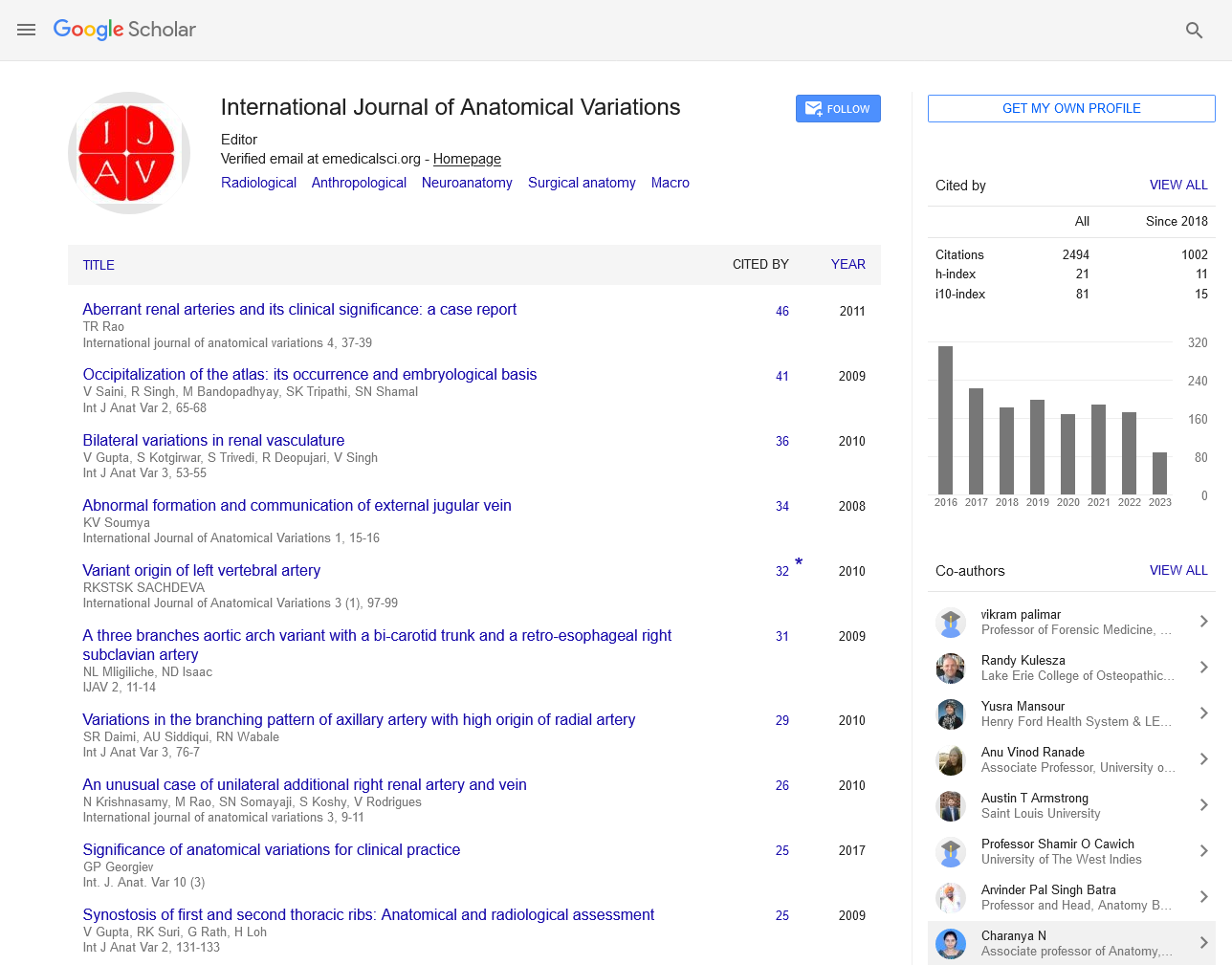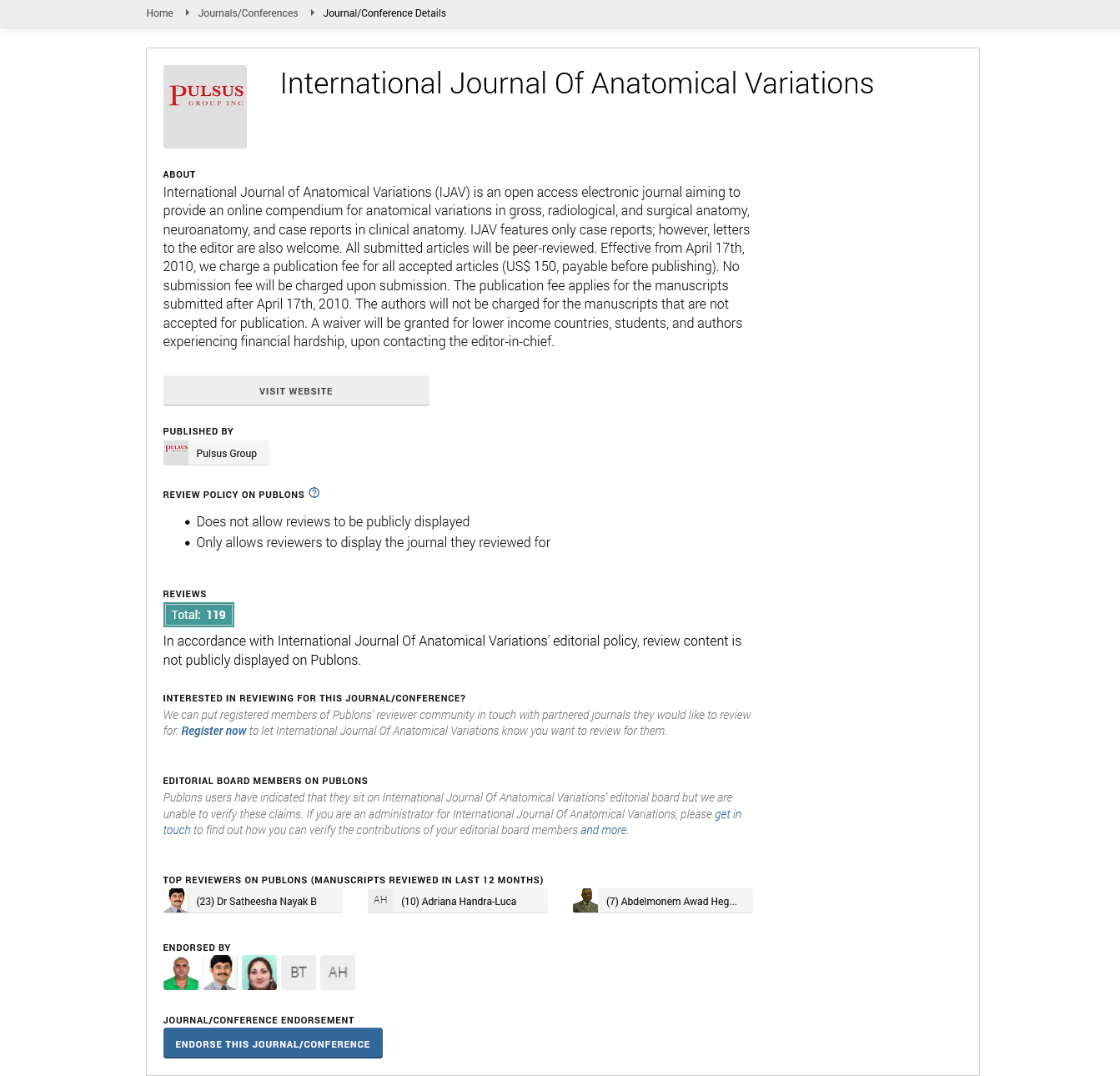Human Anatomy Variability Implications Causes and Clinical Relevance
Received: 01-Feb-2025, Manuscript No. ijav-25-7617; Editor assigned: 04-Feb-2025, Pre QC No. ijav-25-7617 (PQ); Reviewed: 19-Feb-2025 QC No. ijav-25-7617; Revised: 26-Feb-2025, Manuscript No. ijav-25-7617 (R); Published: 28-Feb-2025, DOI: 10.37532/1308-4038.18(2).481
Citation: Kumar A. Human Anatomy Variability Implications Causes and Clinical Relevance. Int J Anat Var. 2025;18(2): 731-732.
This open-access article is distributed under the terms of the Creative Commons Attribution Non-Commercial License (CC BY-NC) (http://creativecommons.org/licenses/by-nc/4.0/), which permits reuse, distribution and reproduction of the article, provided that the original work is properly cited and the reuse is restricted to noncommercial purposes. For commercial reuse, contact reprints@pulsus.com
Abstract
Human anatomy has traditionally been taught using a “standard” model; however, significant variability exists across individuals. This article explores the sources, extent, and significance of anatomical variations in humans. These variations can stem from genetic, environmental, developmental, and evolutionary factors. Recognizing these differences is essential in clinical practice, education, surgical planning, and personalized medicine. This review synthesizes recent findings on anatomical variability and outlines its implications for healthcare professionals and anatomists.
INTRODUCTION
The study of human anatomy forms the cornerstone of medical education and practice. Historically, anatomical understanding has been grounded in the "normative" model derived from a small number of cadaveric dissections, often of European male origin. However, over time, it has become evident that significant variation exists in the anatomical structures of individuals. These variations can be minor or major, congenital or acquired, and may have substantial clinical consequences [1]. Understanding and appreciating anatomical variability is therefore critical in enhancing diagnostic accuracy, surgical outcomes, and the personalization of medical care. Human anatomy has long been regarded as a foundational pillar of medical science, with textbooks and curricula historically built around a standardized model of the human body. While this "normative" anatomical framework has been instrumental in educating generations of healthcare professionals, it does not fully capture the rich diversity and complexity inherent in human structure. Anatomical variability — the natural differences in the size, shape, position, and presence of anatomical features — is a well-documented phenomenon that occurs across individuals, populations, and ethnic groups. These variations may be subtle, such as the absence of the palmaris longus muscle, or more clinically significant, such as differences in vascular branching patterns or nerve trajectories. The causes of such variability are multifactorial, encompassing genetic, developmental, environmental, and evolutionary influences. While many anatomical differences are benign, others may have direct implications for diagnosis, surgical planning, and medical treatment. For example, unexpected variations in vascular anatomy can complicate minimally invasive procedures [2], and developmental anomalies can mimic pathological conditions on imaging studies. In the era of precision medicine and individualized care, the importance of understanding anatomical variability is greater than ever. Clinicians, anatomists, and medical educators must move beyond the notion of a single "ideal" human form and embrace a more nuanced appreciation of human diversity. This article explores the underlying causes of anatomical variability, discusses its wide-ranging clinical implications, and emphasizes its relevance in contemporary medical practice and education.
SOURCES OF ANATOMICAL VARIABILITY
Genetic variation plays a foundational role in anatomical differences. Variations in gene expression, mutations, and polymorphisms contribute to structural differences across individuals and populations. For instance, variations in the HOX gene clusters influence limb development and vertebral formation [3].
DEVELOPMENTAL PROCESSES
Errors or divergences in embryological development can lead to anatomical anomalies. Some examples include persistent left superior vena cava, cervical ribs, and bifid ureters. While some developmental variations remain asymptomatic, others can result in clinical complications.
EVOLUTIONARY AND POPULATION DIFFERENCES
Evolutionary pressures and adaptation to environmental conditions have led to population-specific anatomical traits. For example, the variation in nasal shape across populations is correlated with climatic adaptation. Skeletal and muscular differences among populations also reflect both genetic lineage and environmental influences [4].
ENVIRONMENTAL INFLUENCES
Nutrition, physical activity, disease exposure, and other environmental factors can influence anatomical development. For instance, prolonged malnutrition in early life may affect bone density and stature, while repetitive motion in specific professions can lead to hypertrophy or deformities in musculoskeletal structures.
SURGICAL IMPLICATIONS
Unawareness of anatomical variants can lead to iatrogenic injuries during surgery. For instance, a surgeon unaware of an accessory bile duct might inadvertently damage it during cholecystectomy.
RADIOLOGICAL INTERPRETATION
Radiologists must differentiate between normal anatomical variants and pathological conditions. For example, a prominent Eustachian valve may mimic a cardiac mass on echocardiography [5].
PERSONALIZED MEDICINE
With the rise of personalized medicine, recognizing individual anatomical differences has become even more crucial. Tailoring procedures like implant design, radiation therapy, and organ transplantation requires detailed anatomical understanding.
MEDICAL EDUCATION
Incorporating variability into anatomical education can help future physicians develop a realistic understanding of human structure, improving their diagnostic and surgical skills.
CHALLENGES AND FUTURE DIRECTIONS
Future efforts should aim to integrate anatomy, genomics, and artificial intelligence to build comprehensive models of human variability, ultimately improving health outcomes worldwide.
CONCLUSION
Human anatomy is inherently variable, shaped by a complex interplay of genetic, environmental, and developmental factors. Recognizing and understanding this variability is essential for safe and effective medical practice. As medicine continues to move toward individualized care, the appreciation of anatomical differences will only grow in importance. Education, research, and clinical practice must evolve to reflect the rich diversity of human anatomy.
REFERENCES
- Tortora G J, Funke B R, Case C L (2010) Microbiology an Introduction. 1st ed. Pearson Education Inc, San Francisco, USA 622-624.
- WHO (2010) Rabies vaccines WHO position paper. Weekly Epidemiological Record 85: 309-320.
- Zinsstag J, Durr S, Penny M A, Mindekem R, Roth F et al. (2009) Transmission dynamics and economics of rabies control in dogs and humans in an African city. PNAS 106: 14996-15001.
- Taame MH, Abrha B H, Yohannes T A, Abreha T G, Yisehak TR et al. (2017) Control and prevention of rabies through dog vaccination campaigns, public awareness creation and dog population control. Ethiop J vet Sci Anim Prod 1: 9-16.
- Tenzin (2012) Studies on the epidemiology and control of rabies in Bhutan. PhD Thesis. The University of Sydney, Faculty of Vet Sci Australia.
Indexed at, Google Scholar, Crossref






